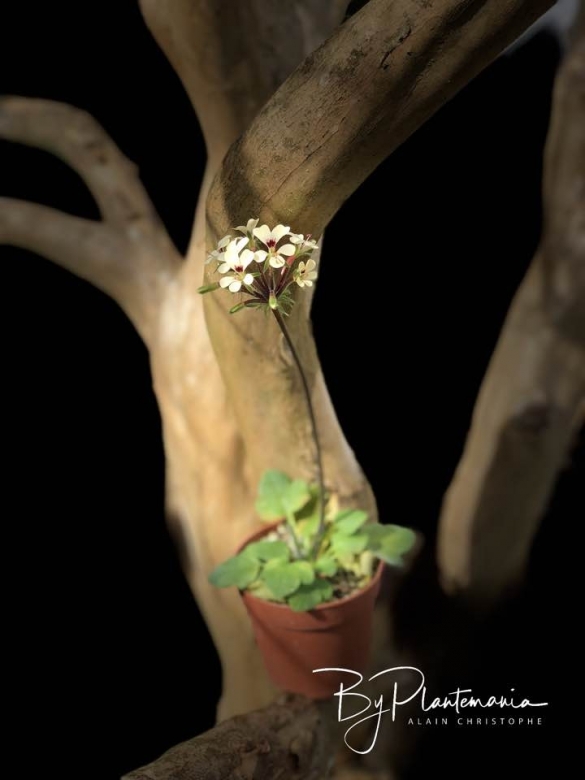Accepted Scientific Name: Pelargonium moniliforme E.Mey. ex Harv.
Fl. Cap. (Harvey) 1: 264. 1860 [10-31 May 1860] Harv.

Geraniospermum moniliforme (Pelargonium moniliforme) Photo by: © Plantemania
(Skimmelberg)
Origin and Habitat: Pelargonium moniliformeSN|35201]]SN|35201]] is widely scattered in the west coast of Southern Africa (Karroo and Namaqualand).
Habitat and ecology. It seems to prefer the higher levels, such as the summits of the stony hills and hard, gravel-strewn ground. As the inflorescence may be up to over 30 cm in height such dwarf plants are readily overlooked, and when not in flower are not noticed at all.
Synonyms:
Description: Pelargonium moniliforme is a dwarf, stemless, tuberous-rooted species and somewhat variable both in the leaves and the flowers. The root system is a string of roundish tubers, connected by a slender cord, several such nodosities lie one above the other. The leaves are numerous,oak-leaf-like, and form a neat little rosette flat on the soil and the flowers are creamy-white with large red blotch at the base of the narrow petals.
Root system: Moniliform. A series of roundish —starch storing— tubers connected by a very thin, tough, fibrous root, in rows as if they were strung on.
Leaves: Few to several, radical, poorly developed on pilose petioles, thin and membranous, spreading, oblong or ovate, obtuse, tapering at base, simple to tripartite, irregularly crenato-lobulate (oak-leaf-like), upper face more or less pubescent with long glandular, lower face with hairy main veins. Stipules subulate.
Inflorescences: Scapes elongate 35-40(55) cm long when flowering, quite simple (unbranched), leafless rising from the basal cluster of leaves, patently pilose. Bracts densely barbate, umbels 12–20-(40)-flowered.
Flowers: Flowers sessile, creamy white, the upper petals with purple blotches. Calyx tube (hypanthium) patently hispid, 5–6 times as long as the petals. Petals linear, spatulate, obtuse, creamy-white to pale yellow, bearded. Upper two petals with wine-red blotches in the centre, lower 3 sometimes also with blotches. fertile stamens 5, long, protruding from the flower, remaining stamens straight. Anthers wine-red. Pollen orange; Style dark pink.
Related species: P. moniliforme is closely related to Pelargonium vinaceum, but it is clearly distinguished by its much taller inflorescence with a larger number of flowers, larger flowers and longer hypanthia, and the number of fertile stamens is always 5. Pelargonium vinaceum occurs more to the north but the distribution areas of both taxa overlap.
Bibliography: Major references and further lectures
1) W. H. Harvey, “Flora Capensis”, Vol 1, 1894
2) Urs Eggli “Illustrated Handbook of Succulent Plants: Dicotyledons” Springer, 2002
3) Foden, W. & Potter, L. 2005. Pelargonium moniliforme Harv. National Assessment: Red List of South African Plants version 2017.1. Accessed on 2018/03/19
4) Geraniaceae Group “Superseded Genera of Pelargonium" Geraniaceae Group, 23 apr 2004
5) William J. Webb, “The Pelargonium Family: The Species of Pelargonium, Monsonia, and Sarcocaulon” Croom Helm, 1984
6) John Hutchinson “A botanist in southern Africa” P. R. Gawthorn ltd., 1946
7) Pelargonium moniliforme in: “Gardeners Chronicle & New Horticulturist”, Haymarket Publishing, 1934
8) Pelargonium moniliforme in: “Journal of the Royal Horticultural Society”, Royal Horticultural Society (Great Britain). The Society., 1934
Cultivation and Propagation: Pelargonium moniliformeSN|35201]]SN|35201]] needs a long resting period of complete dryness, nor must the rootstock get too baked during hot weather — for summer is the resting season — when grown in pots. For a plant the pot is a very poor substitute for the top of a stony, windswept hill which, though experiencing very hot spells, is invariably quite cool below the surface.










